AMD Radeon HD 7870 GHz Edition & Radeon HD 7850 Review: Rounding Out Southern Islands
by Ryan Smith on March 5, 2012 12:01 AM ESTMeet The Radeon HD 7870 & Radeon HD 7850
For today’s review AMD sent over a 7870 and a 7850. Both are built on the 7870 reference design, so the cards are functionally identical except for the configuration of their respective GPU and the number of PCIe power sockets present.
For retail cards this will be very similar to the 7700 series launch, with partners doing semi-custom cards right away. In fact among the list of cards AMD sent us only Club3D will be using the complete 7870 reference design, while everyone else will be using the reference PCB along with their customary open air coolers. The 7850 will be even more divergent since AMD actually has a different, shorter reference PCB for these cards. Consequently our 7850 has very little in common with retail 7850s when it comes to their construction.
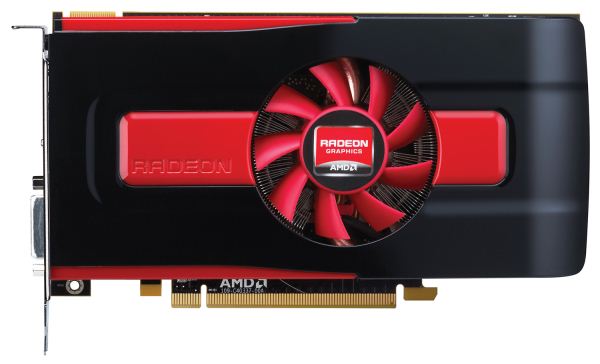
The Radeon HD 7850 Reference Design - Only Sampled To Partners
Starting as always with the cooler, the 7870 reference design is effectively a smaller version of the 7970 reference design. Here AMD is once again using a blower design with a slightly smaller blower, shrouded in the same hard red & black plastic as with the 7900. Underneath the shroud we find AMD’s heatsink, which utilizes a copper baseplate attached to 3 copper heatpipes, which in turn run into an aluminum heatsink that runs roughly half the length of the card. This is fairly typical for a blower design for a sub-200W card, but again almost all of the retail cards will be using a completely different open air design.
The 7870 PCB itself runs 9.5” long, with an additional .25” of shroud overhang bringing the total to 9.75”. Our card is equipped with 8 5GHz 256MB Hynix GDDR5 memory chips, the same 5GHz chips that we saw on the 7700 series. For the 7870 power is provided by a pair of 6pin PCIe power socket, while the sub-150W 7850 uses a single socket. Both cards feature a single CrossFire connector, allowing them to be paired up in a 2-way CrossFire configuration.
Meanwhile for display connectivity AMD is using the same configuration as we’ve seen on the 7900 series: 1 DL-DVI port, 1 HDMI port, and 2 miniDP ports. Interestingly, unlike the 7900 series and 7700 series there is a set of pads for a second DVI port on the card, and while AMD doesn’t make use of them at least one XFX card will. The 7800 series as the same display configuration options as the 7900 series though, so while it can drive up to 6 monitors it can only drive 2 TMDS type displays at once, and if you want to drive a full 6 monitors you’ll need a MST hub.
Finally, I wanted to touch on marketing for a bit. We typically don’t go into any detail on marketing, but with the 7800 something AMD did caught my eye. One of AMD’s marketing angles will be to pitch the 7800 series as an upgrade for the 5800 series; AMD doesn’t typically pitch cards as upgrades in this manner, and the 5800 comparison is especially odd.
At 2.5 years old the 5800 series is no longer the video card king but it’s also not particularly outdated; other than tessellation performance it has held up well relative to newer cards. More specifically, the 7800 series performance is roughly equal to the 6900 series, and while the 6900 series as a step up from the 5800 series it was not a massive leap. With its $350/$250 MSRP the 7800 series has common pricing with the 5800 series, but at only 20-40% faster than the 5800 it’s not the kind of step up in performance that typically justifies such a large purchase. Of course AMD’s conservative pricing has a lot to do with this, but at the end of the day it’s odd to call the 7800 series the upgrade for the 5800 series when the 7950 is the more natural upgrade from a performance perspective.


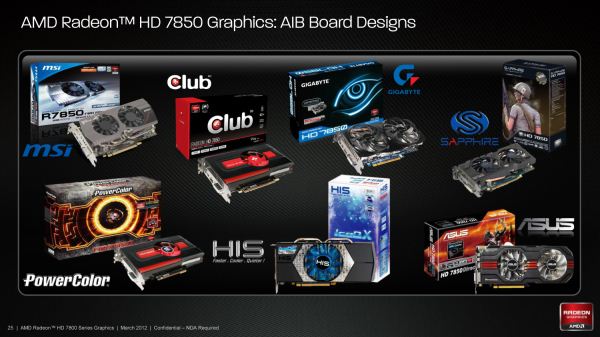
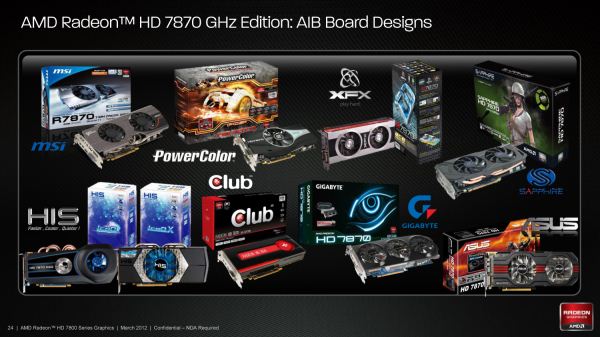

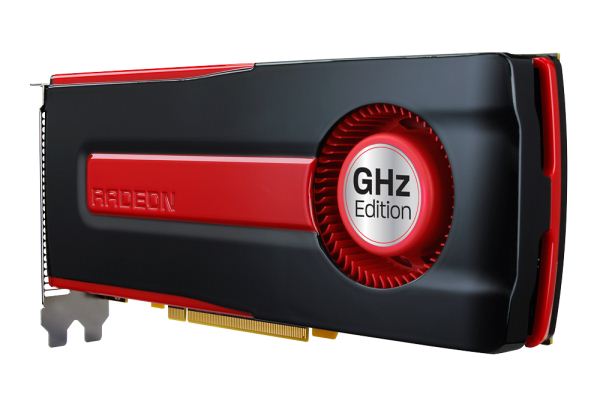












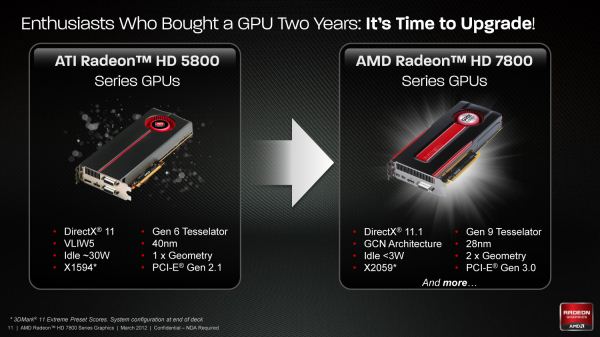








173 Comments
View All Comments
rburnham - Monday, March 5, 2012 - link
I tend to skip one or two generations of video cards before upgrading, but the 7850 looks like a fairly respectable upgrade over my current 6850. I love that low power draw, although I might wait until someone like MSI comes out with a quieter version.CeriseCogburn - Thursday, March 8, 2012 - link
Your 6850 is 2 watts higher power draw at idle. But you're a gamer, so load draw is important. The 7850 is 14 watts higher power draw on normal load, and 26 watts more on high load. Powertune slider only increases that.smoka - Monday, March 5, 2012 - link
A lot of people are saying power draw is not important, but it is for some of us upgrading. I have been running a GTX460 for about a year now and I'm finally thinking about jumping on the Eyefinity bandwagon. I was eying the 6950 a few weeks ago, but I decided to wait for the 78xx to come out. My plan is to move to a single card and run at a lower resolution (3072x768 or 3840x1024) until I can upgrade to a CF setup and run at 5760x1080.Also keep in mind that I have a 600W PSU, which would need an upgrade a 69xx CF or GTX570/580 SLI setup. Many people who are in the mid-high end gaming market (which the 78xx is aimed at) don't have a 1000W PSU. Upgrading to these top-tier PSUs is also another expense to add to an already expensive graphics card overhaul.
The 7870 series fits the bill exactly for me, except for the $350 price-point. I really wanted the it to be priced at $300 or less. I am hoping it will hit this price either due to brand competition, store promotion, or after kepler release.
kallogan - Monday, March 5, 2012 - link
Actually i care about power consumption more than stupid power hungry raw performance.You are not responsible citizens when buying nvidia stuff. Buy amd and save the planet.
HAHA
compvter - Monday, March 5, 2012 - link
Sure performance/price matters most, but what i find interesting in current amd generation cards is zerocore that allows me to keep my computer running with low power draw when i don't use it. I don't really care about power draw when i am using computer, but i do care about noise, and those are kind of related. Still most of the cards are silent enough for me, but most of the time my coputer is on idle (or long idle) with software running that i can't turn off (irc client), so zerocore would save me a lot of money compared to Nv offerings. Still i am interested to see what nv offers, but at the moment im considering 7870 to replace my 3870x2. Would go 79xx, but don't want to buy new case =/mattgmann - Monday, March 5, 2012 - link
save the planet...lol. Though saving on the electricity bill would be nice. The power hungry 4890 tandem in my rig surely adds a few tens of dollars a month to my bill.pieguy - Monday, March 5, 2012 - link
In the paragraph about 7800 series voltage, you mention 7950 voltages but I think you mean 7850 voltage, else I am not understanding...Also, a question about these voltages of 1.213 - 1.219. I don't know much on the subject. If these are the voltages under load, what are they actually set to (before vdroop)? If this voltage is standard for these cards, does it mean that we shouldn't be concerned about using this voltage on other 28nm 7XXX series cards for extra OC headroom and 24/7 usage? I'm just trying to figure out a max "safe" 24/7 voltage for my 7950 since the overclocking scales really well with voltage increases.
Thanks for the great review!
Ryan Smith - Monday, March 5, 2012 - link
Hi Pie, thanks for the correction. As for the voltages, those are the VIDs, so it's without vdroop. As for what a safe voltage is, there's no easy answer to that. Though 1.21v is likely safe for 7900 cards that are already in the 1.17v range.ObeseMaurice - Monday, March 5, 2012 - link
I bought a 2GB 6950 2 weeks ago for $240 and $20 mail in rebate. The 7870 is worse on all resolutions of Battlefield 3 and priced significantly higher. Very unimpressive product launch from AMD.silverblue - Monday, March 5, 2012 - link
Has anybody stopped to think how much extra performance you might get from these cards when AMD has proper drivers for them, or is this considered a moot point? Needless to say, nowhere on the BF3 benchmarks in this review is the 7870 slower than the 6950, rather it's a consistent 20% faster. Throughout the review the 7870 ranges from about 15% (Batman 1920x1200) - 70% (Civ5 1920x1200) faster depending on the title. Granted, the gap isn't always this large at 2560x1600 but it's still sizeable in a good number of cases. Are you in fact referring to the 7850?AMD are pricing these cards at that level because they can. It's certainly not going to last forever.